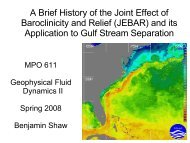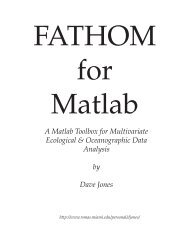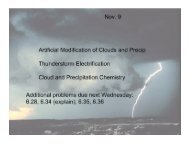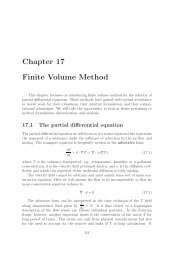2007 (PDF) - Rosenstiel School of Marine and Atmospheric Science ...
2007 (PDF) - Rosenstiel School of Marine and Atmospheric Science ...
2007 (PDF) - Rosenstiel School of Marine and Atmospheric Science ...
Create successful ePaper yourself
Turn your PDF publications into a flip-book with our unique Google optimized e-Paper software.
Sustainability<br />
We have entered an important era in underst<strong>and</strong>ing <strong>and</strong> mitigating<br />
the complex interactions between humans <strong>and</strong> our environment.<br />
The world is in urgent need <strong>of</strong> focused scientific research on the<br />
sustainability <strong>of</strong> the world’s natural resources. <strong>Rosenstiel</strong> scientists<br />
are helping to provide a clear <strong>and</strong> hopeful vision for the future <strong>of</strong><br />
aquaculture, the economics <strong>of</strong> coastal communities, marine animal<br />
population growth <strong>and</strong> a mutually beneficial relationship with the<br />
diversity <strong>of</strong> life in <strong>and</strong> around marine <strong>and</strong> freshwater environments.<br />
Transferring Valuable Knowledge<br />
The year <strong>2007</strong> proved pivotal for advancements in aquaculture; a<br />
science dedicated to creating sustainable practices that will meet<br />
growing consumer dem<strong>and</strong> for aquatic foods in a manner that is<br />
environmentally responsible. After<br />
two years <strong>of</strong> collecting data from<br />
scientists, fishermen, aquaculture<br />
practitioners, government regulators<br />
<strong>and</strong> coastal citizens, the U.S.<br />
<strong>Marine</strong> Aquaculture Taskforce<br />
issued its report, Sustainable<br />
<strong>Marine</strong> Aquaculture: Fulfilling the<br />
Promise; Managing the Risks, which<br />
UM Veterinarian Dan Rothen assesses<br />
the health <strong>of</strong> Cobia larvae in<br />
the hatchery. Photo credit: UM/<br />
Aquaculture<br />
recommends guidelines to protect<br />
the health <strong>of</strong> marine ecosystems<br />
through sound adherence by U.S.<br />
based aquaculture programs.<br />
Dr. Daniel D. Benetti, Aquaculture Program director, associate pr<strong>of</strong>essor<br />
<strong>and</strong> chairman <strong>of</strong> the Division <strong>of</strong> <strong>Marine</strong> Affairs & Policy at<br />
the <strong>Rosenstiel</strong> <strong>School</strong>, served as a member <strong>of</strong> the task force. In recent<br />
years, Benetti has grown the thriving Aquaculture Program at<br />
the University <strong>of</strong> Miami into an internationally recognized resource<br />
for sustainable aquaculture practices. He <strong>and</strong> his graduate students<br />
are currently involved in transferring technology to endeavors on<br />
nearly every continent, in industrialized <strong>and</strong> developing nations.<br />
Dr. Daniel Benetti exits a state-<strong>of</strong>-the -art Aquapod <strong>of</strong>f the coast <strong>of</strong> Puerto<br />
Rico. Photo credit: Brian O’Hanlon, president <strong>of</strong> Snapperfarm, Inc.<br />
The advanced research being conducted at the <strong>Rosenstiel</strong> <strong>School</strong><br />
is helping to further develop hatchery <strong>and</strong> growout technology<br />
around the world. A state-<strong>of</strong>-the-art experimental marine finfish<br />
hatchery located on Virginia Key, Florida is providing h<strong>and</strong>son<br />
training for students <strong>and</strong> pr<strong>of</strong>essionals in advanced hatchery<br />
management for marine fish production. Emphasis has been given<br />
to pelagic species such as cobia, Seriola <strong>and</strong> most recently, tuna, the<br />
most sought-after species <strong>of</strong> fish because <strong>of</strong> its dangerously declining<br />
wild populations.<br />
The scope <strong>of</strong> the program at the<br />
<strong>Rosenstiel</strong> <strong>School</strong> is as broad as its<br />
student body is diverse. Students<br />
who join the Aquaculture Program<br />
have interests that range from science<br />
<strong>and</strong> technology, to production,<br />
business, regulatory <strong>and</strong> environmental<br />
issues. With nearly 100<br />
percent job placement after graduation,<br />
the Aquaculture Program is<br />
becoming increasingly popular, with<br />
several graduates now leading the<br />
industry <strong>and</strong> establishing their own<br />
companies to support dem<strong>and</strong> in an<br />
ecologically sound manner.<br />
Aaron Welch examines Cobia<br />
as he prepares to relocate it to a<br />
new growout tank. Photo credit:<br />
Barbra Gonzalez<br />
Fishing for Generations<br />
PESCA (Partnership for Ecologically Sustainable Coastal Areas),<br />
a collaborative project between the <strong>Rosenstiel</strong> <strong>School</strong>’s National<br />
Center for Coral Reef Research (NCORE) <strong>and</strong> the PUNTACANA<br />
Ecological Foundation, was established in <strong>2007</strong>. Designed to<br />
provide a sound scientific basis for coastal management in greater<br />
Punta Cana, project leaders are working towards empowering local<br />
communities <strong>and</strong> businesses to actively support environmental<br />
awareness.<br />
Drs. Liana Talaue-McManus, alongside Drs. Larry Br<strong>and</strong>, <strong>and</strong><br />
John McManus from the <strong>Rosenstiel</strong> <strong>School</strong>, began conducting<br />
studies to assess the health <strong>of</strong> marine habitats in the greater Punta<br />
Cana watershed. Using a combination <strong>of</strong> satellite data analyses <strong>and</strong><br />
underwater surveys, they gathered<br />
information to map the major<br />
habitat types in the Punta Cana<br />
Reef Ecosystem. The data collected<br />
also helped to establish a monitoring<br />
program to study nutrient patterns<br />
that might be affecting water<br />
quality <strong>and</strong> seek out their potential<br />
sources. The team also designed<br />
broad socioeconomic studies <strong>of</strong><br />
fishing <strong>and</strong> tourism livelihood,<br />
A total <strong>of</strong> nine skin divers <strong>and</strong> four<br />
SCUBA divers, including Renata<br />
Ferrari, (above) spent the morning<br />
removing marine debris, such as nets<br />
<strong>and</strong> ropes, from the Acropora that grow<br />
prominently in the area. Photo credit:<br />
Megan Stone<br />
which were used to establish the<br />
economic dependence <strong>of</strong> local<br />
residents on reef resources.<br />
As part <strong>of</strong> the environmental<br />
education component <strong>of</strong> PESCA,<br />
<strong>Rosenstiel</strong> students <strong>and</strong> scientists,<br />
<strong>and</strong> staff from the PUNTACANA Ecological Foundation were<br />
joined by PADI AWARE, PUNTACANA Resort <strong>and</strong> Club’s Dive<br />
Shop, Peace Corps volunteers <strong>and</strong> the Asociacion de Pescadores de<br />
Juanillo for a reef <strong>and</strong> beach cleanup day. Fishermen, skin divers<br />
<strong>and</strong> SCUBA divers spent the morning removing marine debris,<br />
Local residents <strong>and</strong> University <strong>of</strong> Miami student Colleen Gatliff participated in<br />
the cleanup which produced four sacks <strong>of</strong> trash <strong>and</strong> removed four nets from the<br />
reef. Photo credit: Benjamin Kushner<br />
such as nets <strong>and</strong> ropes, from the coral reef. Students from the Punta<br />
Cana International <strong>School</strong>, Escuela Basica de Juanillo, <strong>and</strong> Colegio<br />
Politécnico de Veron helped with beach cleanup on Cabo Engaño,<br />
the easternmost point on Hispaniola.<br />
The team’s overall goal<br />
is to help educate <strong>and</strong><br />
foster stewardship <strong>of</strong><br />
natural resources in the<br />
region. By analyzing<br />
policies <strong>and</strong> regulatory<br />
instruments, along with<br />
ecological <strong>and</strong> socioeconomic<br />
data, PESCA<br />
hopes to provide options<br />
to resource users<br />
Elementary <strong>and</strong> high school students from three<br />
different schools were organized to help in the beach<br />
that will help to conserve cleanup on Punta Cana’s coral reefs. Photo credit:<br />
the reef system for the Benjamin Kushner<br />
long term.<br />
Solomon Isl<strong>and</strong>s Subsistence<br />
Damaged home in the town<br />
<strong>of</strong> Paelongi on Ghizo Isl<strong>and</strong>.<br />
Photo credit: Kelly L. Jackson<br />
What began as an early morning rumble that shook coconut palm fronds to the ground, evolved into<br />
the biggest natural disaster ever to hit the western Solomon Isl<strong>and</strong>s. An earthquake lasting just over<br />
one minute, registering 8.1 on the Richter scale, triggered a tsunami that left thous<strong>and</strong>s in Western <strong>and</strong><br />
Choiseul provinces homeless <strong>and</strong> 52 dead. Amid the rapid response teams from global relief agencies<br />
were a team <strong>of</strong> scientists, including Kelly Jackson, a <strong>Rosenstiel</strong> <strong>School</strong> graduate assistant who spent three<br />
weeks assessing the effects the tsunami had on the geology <strong>of</strong> the Solomon Isl<strong>and</strong>s.<br />
Jackson, a student in the <strong>Rosenstiel</strong> <strong>School</strong>’s Division <strong>of</strong> <strong>Marine</strong> Geology <strong>and</strong> Geophysics, applied her<br />
knowledge <strong>of</strong> sedimentology <strong>and</strong> ancient geological records during her visit. The team traveled to<br />
severely damaged villages on the isl<strong>and</strong>s <strong>of</strong> Ghizo, Ranongga <strong>and</strong> Simbo, as well as several small,<br />
uninhabited reef-isl<strong>and</strong>s. The team witnessed homes made <strong>of</strong> thatched grasses <strong>and</strong> palm fronds <strong>and</strong><br />
vehicles that floated tens <strong>of</strong> meters inl<strong>and</strong>, <strong>and</strong> were deposited with surprisingly little damage, suggesting<br />
that the wave came in not as a turbulent bore, but rather as a rapidly<br />
rising tide.<br />
The purpose <strong>of</strong> the survey was to document the changes to the coastal geology<br />
<strong>of</strong> the region, focusing on sediment transport on <strong>and</strong> <strong>of</strong>f shore, to see<br />
how tsunamis are potentially recorded in the long-term geological record.<br />
The earthquake <strong>and</strong> resulting tsunami caused extensive damage to coral<br />
reefs, coastal erosion, <strong>and</strong> in some locations, three meters <strong>of</strong> uplift, subsidence,<br />
<strong>and</strong> l<strong>and</strong>slides. In a community largely dependent on fishing <strong>and</strong><br />
tourism, the extensive damage to the isl<strong>and</strong>s’ many coral reefs, will leave a<br />
significant imprint on both the geology <strong>and</strong> economy <strong>of</strong> the region.<br />
People walking across exposed corals on the isl<strong>and</strong> <strong>of</strong> Ranongga.<br />
Photo credit: Wilson Billy Rafiau - Department <strong>of</strong> Mines<br />
& Energy, Solomon Isl<strong>and</strong>s<br />
17 18


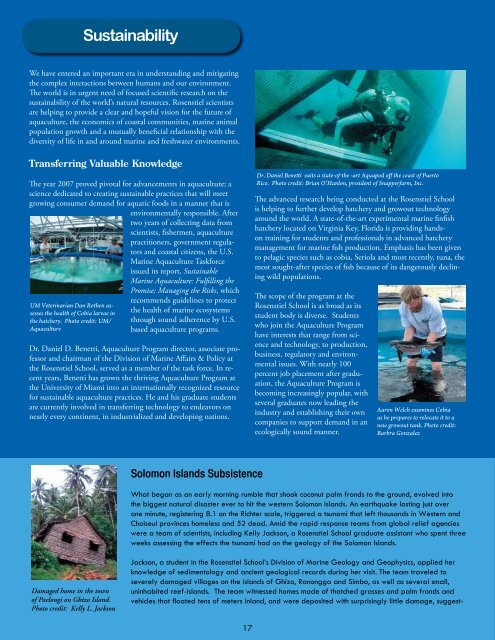

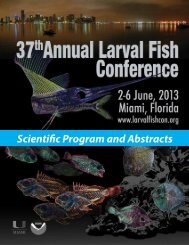
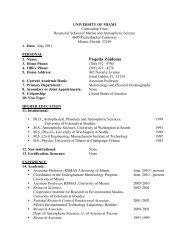
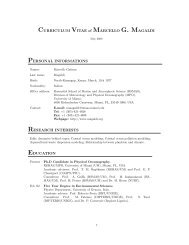
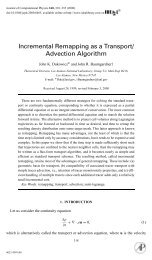
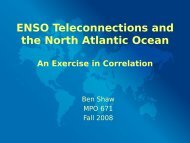
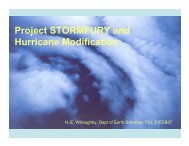
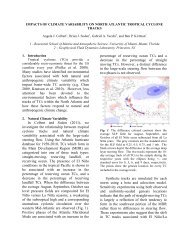
![Wavelength [μm] ZENITH ATMOSPHERIC TRANSMITTANCE](https://img.yumpu.com/26864082/1/190x143/wavelength-i-1-4-m-zenith-atmospheric-transmittance.jpg?quality=85)

